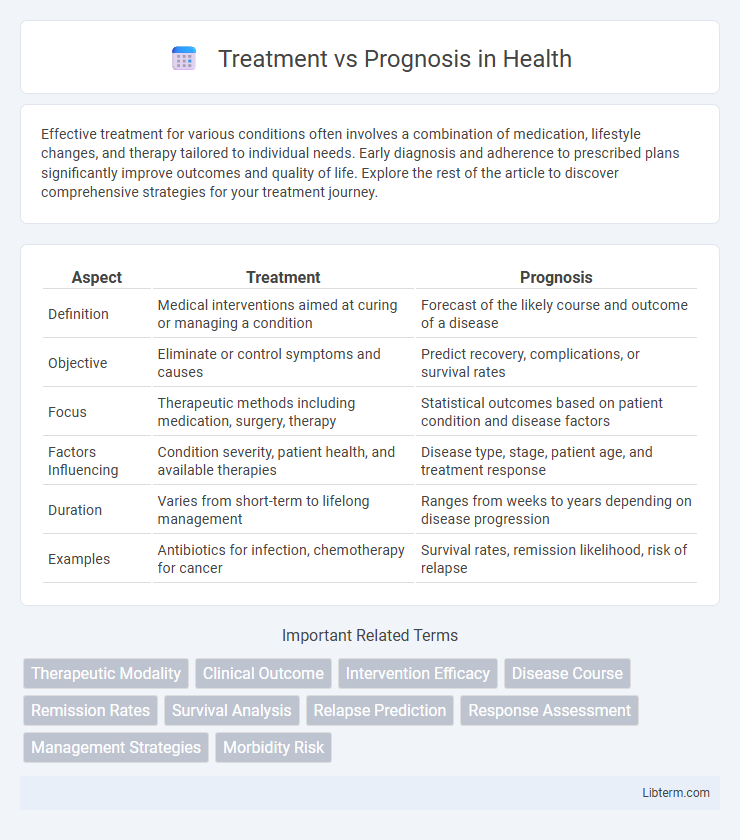Effective treatment for various conditions often involves a combination of medication, lifestyle changes, and therapy tailored to individual needs. Early diagnosis and adherence to prescribed plans significantly improve outcomes and quality of life. Explore the rest of the article to discover comprehensive strategies for your treatment journey.
Table of Comparison
| Aspect | Treatment | Prognosis |
|---|---|---|
| Definition | Medical interventions aimed at curing or managing a condition | Forecast of the likely course and outcome of a disease |
| Objective | Eliminate or control symptoms and causes | Predict recovery, complications, or survival rates |
| Focus | Therapeutic methods including medication, surgery, therapy | Statistical outcomes based on patient condition and disease factors |
| Factors Influencing | Condition severity, patient health, and available therapies | Disease type, stage, patient age, and treatment response |
| Duration | Varies from short-term to lifelong management | Ranges from weeks to years depending on disease progression |
| Examples | Antibiotics for infection, chemotherapy for cancer | Survival rates, remission likelihood, risk of relapse |
Introduction to Treatment and Prognosis
Treatment involves the medical interventions and therapies aimed at managing or curing a disease, tailored to the patient's specific condition and severity. Prognosis refers to the predicted course and outcome of a disease, including the likelihood of recovery, potential complications, and long-term health impacts. Understanding both treatment options and prognosis is essential for effective clinical decision-making and patient counseling.
Defining Treatment in Healthcare
Treatment in healthcare refers to the deliberate management and care of a patient to combat disease, alleviate symptoms, or improve health outcomes, encompassing medical procedures, medications, therapies, and lifestyle interventions. It aims to address the underlying cause or provide symptomatic relief, tailored based on diagnosis, patient condition, and evidence-based protocols. Effective treatment significantly influences prognosis but is distinct from it, as prognosis predicts the future course and outcome of a disease without direct intervention implications.
Understanding Prognosis: What It Means
Understanding prognosis involves predicting the likely course and outcome of a disease based on factors such as patient age, disease stage, and response to treatment. Prognosis helps guide medical decisions by estimating survival rates, potential complications, and overall quality of life. Unlike treatment, which actively manages symptoms and aims to cure or control illness, prognosis provides a forecast to inform patient expectations and care planning.
Key Differences Between Treatment and Prognosis
Treatment involves the medical interventions or therapies, such as medications, surgeries, or physical therapy, aimed at managing or curing a disease. Prognosis refers to the predicted outcome or course of a disease, including the likelihood of recovery, progression, or survival based on clinical factors and patient history. While treatment addresses the active management of the condition, prognosis provides insight into future expectations and disease trajectory.
Factors Influencing Treatment Plans
Treatment plans are influenced by a multitude of factors including the patient's age, overall health, disease stage, and genetic markers of the condition. Comorbidities and potential drug interactions play a critical role in tailoring specific therapies, ensuring efficacy while minimizing adverse effects. Advances in personalized medicine and molecular diagnostics increasingly guide clinicians in selecting optimal treatment modalities aligned with individual prognostic indicators.
Variables Affecting Prognosis Outcomes
Treatment effectiveness depends on multiple factors including the type and stage of the disease, patient age, genetic predispositions, and overall health. Prognosis outcomes vary based on tumor grade, response to therapy, presence of comorbidities, and molecular biomarkers such as HER2 or BRCA mutations. Monitoring these variables enables personalized treatment plans and more accurate predictions of survival rates and disease progression.
The Role of Early Diagnosis in Treatment and Prognosis
Early diagnosis significantly improves treatment effectiveness by enabling targeted therapeutic interventions before disease progression, thereby enhancing patient outcomes. Timely identification of pathological conditions facilitates personalized treatment plans and prevents complications that could worsen prognosis. This proactive approach reduces morbidity rates and increases survival chances across various medical conditions.
Impact of Treatment on Prognosis
Treatment significantly influences prognosis by altering disease progression, improving survival rates, and enhancing quality of life. Early and appropriate interventions, such as chemotherapy for cancer or antivirals for infections, directly reduce complications and mortality. Tailored treatment plans based on patient-specific factors and disease characteristics optimize clinical outcomes and long-term prognosis.
Common Misconceptions about Treatment vs Prognosis
Common misconceptions about treatment vs prognosis often confuse curing a disease with predicting its outcome. Treatment refers to interventions aimed at managing or eliminating a condition, while prognosis estimates the likely disease course and patient recovery chances based on factors like disease stage and patient health. Misunderstanding this distinction can lead to unrealistic expectations about treatment effectiveness and the timeline for recovery.
Conclusion: Integrating Treatment and Prognosis for Better Patient Care
Integrating treatment and prognosis enhances patient care by enabling personalized medical strategies that align therapeutic interventions with likely disease outcomes. Accurate prognosis informs treatment plans, improving decision-making and resource allocation while setting realistic expectations for patients and caregivers. This synergy optimizes clinical results, supports informed consent, and promotes holistic management across diverse medical conditions.
Treatment Infographic

 libterm.com
libterm.com